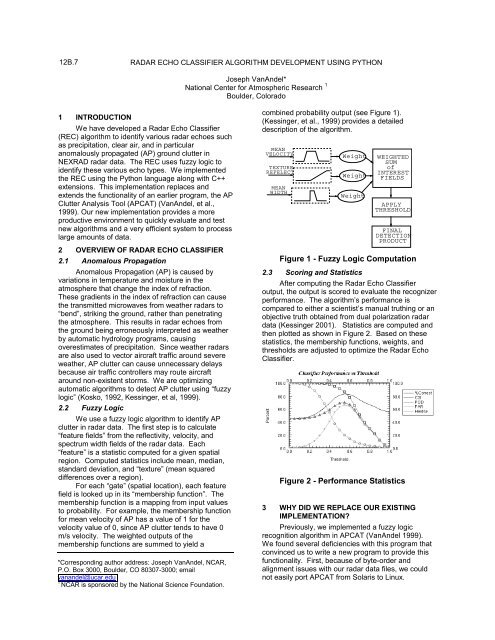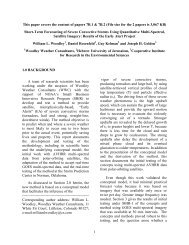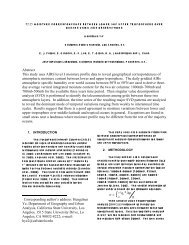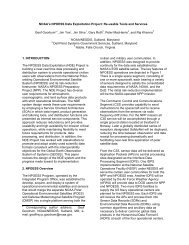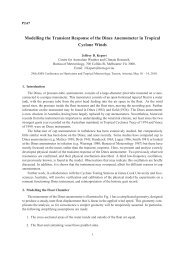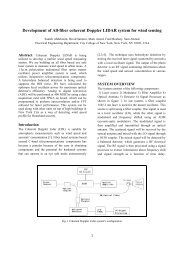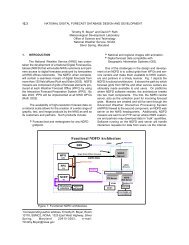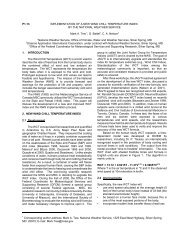radar echo classifier algorithm development using python
radar echo classifier algorithm development using python
radar echo classifier algorithm development using python
Create successful ePaper yourself
Turn your PDF publications into a flip-book with our unique Google optimized e-Paper software.
12B.7<br />
RADAR ECHO CLASSIFIER ALGORITHM DEVELOPMENT USING PYTHON<br />
Joseph VanAndel*<br />
National Center for Atmospheric Research 1<br />
Boulder, Colorado<br />
1 INTRODUCTION<br />
We have developed a Radar Echo Classifier<br />
(REC) <strong>algorithm</strong> to identify various <strong>radar</strong> <strong>echo</strong>es such<br />
as precipitation, clear air, and in particular<br />
anomalously propagated (AP) ground clutter in<br />
NEXRAD <strong>radar</strong> data. The REC uses fuzzy logic to<br />
identify these various <strong>echo</strong> types. We implemented<br />
the REC <strong>using</strong> the Python language along with C++<br />
extensions. This implementation replaces and<br />
extends the functionality of an earlier program, the AP<br />
Clutter Analysis Tool (APCAT) (VanAndel, et al.,<br />
1999). Our new implementation provides a more<br />
productive environment to quickly evaluate and test<br />
new <strong>algorithm</strong>s and a very efficient system to process<br />
large amounts of data.<br />
2 OVERVIEW OF RADAR ECHO CLASSIFIER<br />
2.1 Anomalous Propagation<br />
Anomalous Propagation (AP) is caused by<br />
variations in temperature and moisture in the<br />
atmosphere that change the index of refraction.<br />
These gradients in the index of refraction can cause<br />
the transmitted microwaves from weather <strong>radar</strong>s to<br />
“bend”, striking the ground, rather than penetrating<br />
the atmosphere. This results in <strong>radar</strong> <strong>echo</strong>es from<br />
the ground being erroneously interpreted as weather<br />
by automatic hydrology programs, ca<strong>using</strong><br />
overestimates of precipitation. Since weather <strong>radar</strong>s<br />
are also used to vector aircraft traffic around severe<br />
weather, AP clutter can cause unnecessary delays<br />
because air traffic controllers may route aircraft<br />
around non-existent storms. We are optimizing<br />
automatic <strong>algorithm</strong>s to detect AP clutter <strong>using</strong> “fuzzy<br />
logic” (Kosko, 1992, Kessinger, et al, 1999).<br />
2.2 Fuzzy Logic<br />
We use a fuzzy logic <strong>algorithm</strong> to identify AP<br />
clutter in <strong>radar</strong> data. The first step is to calculate<br />
“feature fields” from the reflectivity, velocity, and<br />
spectrum width fields of the <strong>radar</strong> data. Each<br />
“feature” is a statistic computed for a given spatial<br />
region. Computed statistics include mean, median,<br />
standard deviation, and “texture” (mean squared<br />
differences over a region).<br />
For each “gate” (spatial location), each feature<br />
field is looked up in its “membership function”. The<br />
membership function is a mapping from input values<br />
to probability. For example, the membership function<br />
for mean velocity of AP has a value of 1 for the<br />
velocity value of 0, since AP clutter tends to have 0<br />
m/s velocity. The weighted outputs of the<br />
membership functions are summed to yield a<br />
*Corresponding author address: Joseph VanAndel, NCAR,<br />
P.O. Box 3000, Boulder, CO 80307-3000; email<br />
vanandel@ucar.edu<br />
1<br />
NCAR is sponsored by the National Science Foundation.<br />
combined probability output (see Figure 1).<br />
(Kessinger, et al., 1999) provides a detailed<br />
description of the <strong>algorithm</strong>.<br />
MEAN<br />
VELOCITY<br />
TEXTURE<br />
REFELECT.<br />
MEAN<br />
WIDTH<br />
Weight<br />
Weight<br />
Weight<br />
WEIGHTED<br />
SUM<br />
of<br />
INTEREST<br />
FIELDS<br />
APPLY<br />
THRESHOLD<br />
FINAL<br />
DETECTION<br />
PRODUCT<br />
Figure 1 - Fuzzy Logic Computation<br />
2.3 Scoring and Statistics<br />
After computing the Radar Echo Classifier<br />
output, the output is scored to evaluate the recognizer<br />
performance. The <strong>algorithm</strong>’s performance is<br />
compared to either a scientist’s manual truthing or an<br />
objective truth obtained from dual polarization <strong>radar</strong><br />
data (Kessinger 2001). Statistics are computed and<br />
then plotted as shown in Figure 2. Based on these<br />
statistics, the membership functions, weights, and<br />
thresholds are adjusted to optimize the Radar Echo<br />
Classifier.<br />
Figure 2 - Performance Statistics<br />
3 WHY DID WE REPLACE OUR EXISTING<br />
IMPLEMENTATION?<br />
Previously, we implemented a fuzzy logic<br />
recognition <strong>algorithm</strong> in APCAT (VanAndel 1999).<br />
We found several deficiencies with this program that<br />
convinced us to write a new program to provide this<br />
functionality. First, because of byte-order and<br />
alignment issues with our <strong>radar</strong> data files, we could<br />
not easily port APCAT from Solaris to Linux.
Inexpensive Linux workstations are now providing<br />
better price-performance than Sun workstations, so<br />
we were motivated to build a more portable program.<br />
Second, APCAT was slow in processing data<br />
because it frequently wrote data files to disk for<br />
intermediate storage. Since modern workstations<br />
have far more memory than was previously available,<br />
the new program could keep entire “sweeps” (360<br />
degrees of <strong>radar</strong> data) in memory, rather than writing<br />
out all the intermediate data to disk. Third, APCAT’s<br />
user interface and program logic were written in Tool<br />
Command Language (Tcl) (Ousterhout, 1994). It<br />
became clear that Tcl did not scale well to larger<br />
applications because of its lack of object orientation<br />
and higher-level data types. Python was a natural<br />
choice because it was object-oriented and had<br />
superior data types. Finally, APCAT was a single<br />
monolithic program that could not easily be attached<br />
to other <strong>radar</strong> processing <strong>algorithm</strong>s. Using Numeric<br />
Python (section 4) to implement the REC made it<br />
much easier to add new routines. By simply defining<br />
new routines that read Numeric Python arrays, it was<br />
quite simple to add new <strong>algorithm</strong>s that interface with<br />
our existing programs. As a result, we decided to<br />
implement our fuzzy logic recognition <strong>algorithm</strong> <strong>using</strong><br />
Python.<br />
4 WHAT IS PYTHON?<br />
Python is a very high level interpreted object<br />
oriented programming language (van Rossum and<br />
Drake 2000) with a rich set of data types. Although<br />
Python is easy to learn, it is a very powerful language.<br />
Python is freely available, widely used, and well<br />
supported on a variety of computers and operating<br />
systems. Because Python is interpreted, it is not<br />
suitable (by itself) for computationally intensive tasks.<br />
However, Python is designed to allow extensions that<br />
can perform specialized and computationally intensive<br />
tasks. The Numeric Python extension (Ascher 2001)<br />
was developed to efficiently perform calculations on<br />
large arrays of numbers. Many other extensions are<br />
available, such as database interfaces, graphic user<br />
interfaces (GUI), web programming, and distributed<br />
programming.<br />
5 SOFTWARE ARCHITECTURE<br />
We built the Radar Echo Classifier (REC)<br />
software as a set of C++ extensions for Python and a<br />
collection of Python scripts. First, we built a set of<br />
Python extensions to read NCAR’s DORADE format<br />
<strong>radar</strong> files into Numeric Python arrays. Once the<br />
<strong>radar</strong> data was represented as Numeric Python<br />
arrays, we could use the standard Numeric Python<br />
operators (such as add, subtract, multiply, FFT). We<br />
wrote our own Numeric Python extensions to<br />
efficiently calculate the “feature fields”(section 2.2).<br />
The membership function lookup routine was written<br />
in Python <strong>using</strong> an interpolation routine provided by<br />
Numeric Python. Also, we developed scoring and<br />
statistics routines that analyzed the performance of<br />
the REC. The software architecture is shown in figure<br />
3.<br />
RADAR ECHO CLASSIFIER (REC)<br />
SCRIPTS<br />
NUMERIC<br />
PYTHON<br />
EXTENSIONS<br />
EXTENSION<br />
WRAPPERS<br />
RADAR ECHO<br />
CLASSIFIER<br />
C++ EXTENSIONS<br />
PYTHON CORE<br />
C RUNTIME LIBRARY<br />
Figure 3 – Software Architecture<br />
GRAPHICAL<br />
USER<br />
INTERFACE<br />
EXTENSIONS<br />
(GTK)<br />
Because Python is interpreted, it was simple to<br />
define our fuzzy logic calculation parameters in a<br />
“preference” file that is read when the Radar Echo<br />
Classifier starts running. The preference file defines<br />
the membership function for each “feature field” along<br />
with the weights used to calculate the final result.<br />
This implementation makes it very simple for<br />
scientists to experiment with new membership<br />
functions or weights, without requiring any changes to<br />
the Radar Echo Classifier application code.<br />
6 BENEFITS OF USING PYTHON<br />
We found that implementing the Radar Echo<br />
Classifier in Python had several benefits. First of all,<br />
since Python is interpreted, it was much faster to<br />
develop and test new <strong>algorithm</strong>s, compared to the<br />
edit, compile, debug cycle of compiled languages. We<br />
could easily build small test cases to verify our<br />
<strong>algorithm</strong>s. It was much easier to add new features<br />
than if we only used a compiled language. Since the<br />
computationally intensive <strong>algorithm</strong>s were written as<br />
C++ extensions, our <strong>classifier</strong> could quickly process<br />
large amounts of data, even though large portions of<br />
our application were written in an interpreted<br />
language. We’ve found that Python is very stable and<br />
remarkably bug free, partly because the source is<br />
available to everyone, and many other programmers<br />
are <strong>using</strong> it (and contributing their bug fixes.) Since<br />
the source is freely available, we’ve been able to add<br />
features to the Numeric Python package itself. Also,<br />
since Python is freely available, we can share our<br />
work with other researchers, without requiring them to<br />
purchase software licenses, as would be required with<br />
a commercial software package. When we have<br />
needed assistance with Python, we’ve found the<br />
Python <strong>development</strong> community has quickly<br />
responded to our questions.<br />
7 CONCLUSIONS<br />
Numeric Python provided an excellent<br />
framework for <strong>radar</strong> computations. We have been<br />
able to take advantage of a large set of existing array<br />
manipulation software and have been able to easily<br />
implement our own routines within the Numeric<br />
Python framework. We would strongly recommend
this approach to anyone processing large quantities of<br />
numeric data.<br />
8 FUTURE DIRECTIONS<br />
We plan to expand the Radar Echo Classifier by<br />
adding a “Confidence Algorithm” based on history, the<br />
state of the clutter bypass map, climatology, and<br />
terrain data. We intend to add histograms and scatter<br />
diagrams to help analyze the statistics of our data.<br />
We plan to implement “multi-variable” fuzzy logic,<br />
where the membership function used for a particular<br />
variable depends on the value of a second variable.<br />
9 ACKNOWLEDGEMENTS<br />
The National Weather Service Radar Operations<br />
Center (ROC) in Norman, OK, sponsors this research.<br />
We are grateful to the developers of Python and<br />
particularly the developers of the Numeric extensions.<br />
10 REFERENCES<br />
Ascher, D., P.F. Dubois, K. Hinsen, J. Hugunin, and<br />
T. Oliphant, 2001:Numerical Python, Lawrence<br />
Livermore National Laboratory. See<br />
http://sourceforge.net/projects/numpy<br />
Kessinger, C., S. Ellis, and J. VanAndel, 1999: A<br />
Fuzzy Logic Radar Echo Classification Scheme<br />
for the WSR-88D, Preprints, 29 th International<br />
Conference on Radar Meteorology, AMS,<br />
Montreal, 12- 16 July 1999, 576-579<br />
Kessinger, C., S. Ellis, and J. VanAndel, 2001:<br />
NEXRAD Data Quality: The AP Clutter<br />
Mitigation Scheme, Preprints, 30 th International<br />
Conference on Radar Meteorology, AMS,<br />
Munich, 19-24 July 2001<br />
Kosko, B., 1992: Neural Networks and Fuzzy<br />
Systems: A Dynamical Systems Approach to<br />
Machine Intelligence. Prentice–Hall, N.J.<br />
Ousterhout, J.K., 1994, Tcl and the Tk Toolkit,<br />
Addison Wesley<br />
VanAndel, J., C. Kessinger, and D. Ecoff, 1999:<br />
APCAT: An AP Clutter Analysis Tool, Preprints,<br />
29 th Radar Meteor. Conf., AMS, Montreal, 12-16<br />
July 1999, 267-269<br />
van Rossum, G., F.L. Drake, Python Tutorial,<br />
October 16, 2000<br />
http://www.<strong>python</strong>.org/doc/current/tut/tut.html<br />
(checked 2001/4/2)


